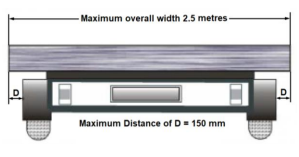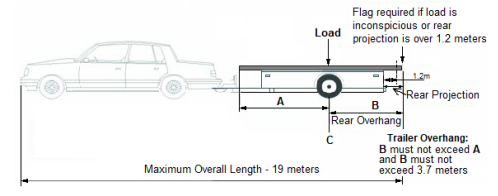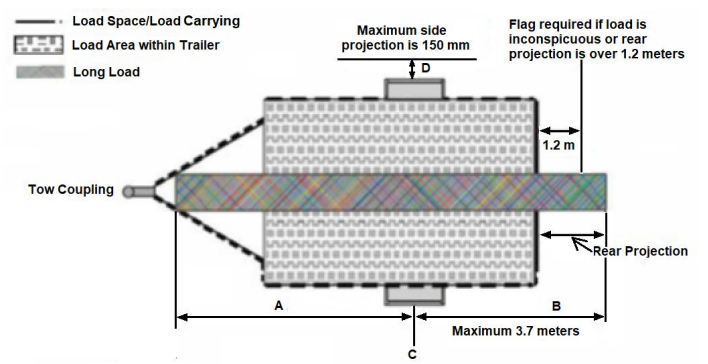On this page
There are a number of regulations that relate to how trailers are loaded and towed by light vehicles - gross vehicle mass (GVM) 4.5 tonnes or less. These regulations ensure that trailers are used effectively and safely, with minimised potential to harm individuals and other road users.
Towing trailers with a load
Before towing a trailer, make sure that all safety measures and towing regulations have been met.
The following information covers the key requirements relating to the towing of trailers. Detailed information is contained in the Road Traffic Act and Regulations, 1961 and Vehicle Standards Bulletin (VSB) 1.
Towing mass limits
The maximum mass that can be towed by a vehicle is dependent upon a number of criteria. The loaded mass of a trailer or caravan must not exceed:
- The rated capacity of both the tow bar and tow coupling.
- The towing mass specified by the vehicle manufacturer, or the gross combination mass (GCM) specified on the vehicle’s registration certificate.
Note: The manufacturer of the towing vehicle may specify two different towing limits or the towing vehicle, depending on whether the trailer is fitted with brakes or not. They may also set requirements when towing, such as maximum speed and tow ball vertical loading.
No manufacturer’s specifications
If the motor vehicle manufacturer has not specified a maximum towing mass and a GCM is not specified on the vehicle’s registration certificate, the rules below apply. These vary according to the trailer’s braking system:
- For a trailer fitted with brakes directly operated by the driver, the mass of the trailer must not exceed 1.5 times the unloaded mass of the towing vehicle.
- For a trailer fitted with override or over-run brakes, the mass of the trailer must not exceed the unloaded mass of the towing vehicle.
- For a trailer not fitted with brakes, the mass of the trailer must not exceed the unloaded mass of the towing vehicle or a gross trailer mass (GTM) of 750 kg, whichever is the lesser.
If a trailer has no manufacturer’s specifications, it is still the owner’s responsibility to make sure the trailer must be safe and fit for purpose.
Trailer braking regulations
- Trailers must be fitted with brakes if the GTM exceeds 750 kg.
- For trailers built to VSB1 and Australian Design Rules (ADRs), override or over-run brakes are acceptable up to a GTM of 2 tonnes.
- For trailers built to UN ECE 13 (acceptable standard under ADR38/05), O2 category (GTM not exceeding 3.5 tonnes) override or over-run brakes are acceptable if fitted with a breakaway system and the trailer is a centre axle trailer.
- Where the GTM exceeds 2 tonnes the braking system must be fitted with a breakaway system that causes the brakes to be applied if the trailer becomes disconnected from the towing vehicle.
Trailer load projections and dimension limits
There are limits to how far loads can project from the back and sides of a trailer.
Side projection
A load must not project more than 150 mm from the outermost part of either side of the trailer and must not be more than 2.5 metres in total width (refer to Figure 1).

Figure 1. Side projection limits
Length of vehicle and trailer
The overall length of the towing vehicle and trailer must not be more than 19.0 metres. The rear of a load on a vehicle must carry a warning signal if the load projects more than 1.2 metres or cannot be easily seen (refer to Figure 2). In the daytime, the warning signal must be a brightly coloured flag measuring at least 300mm x 300mm. At night, the warning signal must be a red light that can be seen for 200 metres.

Figure 2. Front and rear projection limits
Rear projection
Measured from the centre of the trailer axle, or axle group, a load must be:
- not more than 3.7 metres
- no longer than the length of the load in front of the axle, or axle group.

Figure 3. Rear projection
Trailer lighting and wiring
Lights on trailers must operate in unison with those of the towing vehicle - ie the indicator, brake, tail and reversing lights, where fitted, must go on when those of the towing vehicle goes on:
- Required trailer lighting, at the rear of the trailer.
- Number plate light - may be combined with the taillights.
- One pair of brake lights.
- A pair of tail lights - may also be used to delineate the number plate.
- One pair of direction indicator lights may also be used as hazard lights if necessary.
- One pair of red reflectors.
If the trailer is more than 2.2 metres wide, reflectors must be fitted symmetrically to the front of the trailer and within 400 mm of the sides of the trailer. All trailers are required to have an earth wire connected through the wiring back to the towing vehicle. All wiring must be secured at least every 600mm.
Towing rules
A trailer must be securely coupled to the vehicle towing it and must have a safety connection such as a chain or cable that will keep the trailer connected to the towing vehicle in the event of accidental disconnection.
- A trailer must not be towed:
- with a person in or on the trailer
- if the load is placed in a way that causes the combination of towing vehicle and trailer to be unstable.
- The load on a trailer must be safely secured or restrained before moving onto a road.
- If an item falls from the trailer onto the road, it is the driver’s responsibility to remove it from the road.
- Penalties apply if a load is not secured properly.
- A trailer must not be towed unless it meets all the mass, lighting, and braking requirements and is roadworthy.
- A light motor vehicle may tow no more than one vehicle.
Definitions
Gross vehicle mass (GVM) - This is the maximum loaded mass of a motor vehicle set by the vehicle manufacturer.
Gross combination mass (GCM) - In relation to a motor vehicle (towing vehicle), this is the maximum loaded mass of the motor vehicle and of any vehicles or trailers being towed by that motor vehicle.
Aggregate trailer mass (ATM) - The total mass of the trailer when carrying the maximum load recommended by the manufacturer. This will include any mass imposed onto the towing vehicle.
Gross trailer mass (GTM) - This is the maximum loaded mass transmitted to the ground by the axle, or axles, of the trailer when coupled to a towing vehicle. Except for semi-trailers, the difference between the ATM and GTM is usually small.
A = Mass of load
B = Mass on tyres - unloaded trailer
C = Mass on towing vehicle
Aggregate trailer mass (ATM) = A+B+C
Gross trailer mass (GTM) = A+B
Trailers manufactured after 1 July 1988
Trailers manufactured after 1 July 1988 must be constructed in accordance with the requirement specified in Vehicle Standards Bulletin VSB 1.
Towing safety checklist
Use the following checklist to ensure that you meet the safety requirements for towing a trailer:
- All trailer lights — brake, tail and indicator — are all working. You may need someone to help you with this.
- The trailer is securely coupled to the towing vehicle.
- The trailer is safely connected and secured properly to the towing vehicle.
- The trailer is loaded properly as per the 2018 Load Restraint Guide for Light Vehicles.
- The load is safely secured to the trailer and does not present any danger to other people or property if it projects past the trailer body, even if it meets all the dimensions and safety requirements.
- The loaded trailer meets the braking requirements.
- The vehicle combination and load do not exceed the length and projection limits.
- The mass of the trailer and load do not exceed the towing capacity of the vehicle.
- The loaded mass of the trailer does not exceed the tyre capacity and the tyres are inflated to recommended pressures.
Note: Before taking action to alter a trailer, you should first seek advice from the Department for Infrastructure and Transport, and confirm what needs to be done to be sure you do not commit to an unnecessary expense.
Vehicle Standards reference: MR25.

